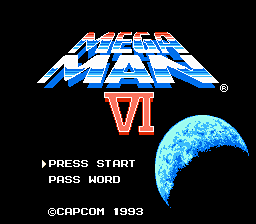
Mega Man 6 (1994-)
Developer: Capcom
Publisher: Capcom
Genre: Platform
Mega Man 6 is a platform action game developed and published by Capcom for the Nintendo Entertainment System, released in 1993 in Japan and later in North America. It is the sixth installment in the core Mega Man series and continues the saga of Mega Man as he battles the evil Dr. Wily, who returns with a new lineup of Robot Masters threatening global security. The game was later re-released as part of various compilation collections, including the Mega Man Anniversary Collection for PlayStation and digital platforms, allowing newer generations of players to experience this NES classic. Inspired by the consistent popularity of the series, Mega Man 6 sought to refine existing gameplay elements while introducing new features to keep the experience engaging and challenging.
In Mega Man 6, players navigate eight themed stages, each controlled by a unique Robot Master with its own set of enemies, environmental hazards, and platforming challenges. The game continues the hallmark mechanic of acquiring the special weapon of defeated bosses, adding strategic depth to the progression of subsequent stages. Mega Man’s robotic companion, Beat, returns to aid in combat, and the game introduces the ability to call upon Rush in new forms to navigate difficult terrain. Stages require precise jumping, timing, and careful use of weaponry, ensuring that both strategy and reflexes are critical for success. The gameplay also includes hidden items and alternate routes, encouraging exploration and rewarding skillful play.
The soundtrack of Mega Man 6 is energetic and carefully composed, with each Robot Master stage featuring a distinctive theme that complements the level’s environment and challenges. Music drives the pace of the action and reinforces the identity of each stage, while sound effects for jumping, shooting, and special attacks provide responsive feedback that enhances the overall gameplay experience. The audio contributes to the immersive feel of the game and is widely praised as one of the series’ stronger NES-era soundtracks, with melodies that remain memorable to fans of the franchise.
Mega Man 6 was promoted as a continuation of the acclaimed Mega Man series, emphasizing its new stage designs, improved gameplay mechanics, and familiar yet refined features such as Beat and Rush. Upon release, it received positive reception for its polished gameplay, challenging difficulty, and creative level design, though some critics observed that the game closely followed the formula of earlier entries. Its success ensured the continuation of the series with Mega Man 7 on more advanced hardware, cementing the franchise’s position as a staple of platform gaming. Over time, Mega Man 6 has been included in multiple compilation releases, preserving its status as a classic entry in the NES Mega Man series and maintaining its appeal among retro gaming enthusiasts.
Images from MobyGames
Buy Mega Man 6
Click one of the Ebay or Amazon buttons below to check the latest prices and purchase Mega Man 6 for the Nintendo Entertainment System.

Related Searches
Mega Man 6 NES Download
Mega Man 6 is available to purchase and download from a range of vendors. Always shop around...
Mega Man 6 NES Manual
Various repositories around the internet have scanned and archived a range of retro manuals. Search now to.....
Mega Man 6 NES Rom
We don't host or link to rom sites for this game. However, there are many sites out there that may be...
Mega Man 6 NES Walkthrough
Many sites - particularly YouTube - host a range of walkthrough videos to guide you in your quest to get...
Mega Man 6 NES Cheats
There are various sites out there that can offer cheat codes for games. Search now to find all available...
Mega Man 6 NES Controls
This information can often be obtained through the user manual. Alternatively there are many sites out there...
Mega Man 6 NES Release Date
The initial release date for Mega Man 6 is stated as March 1994. Other ports of the game may..
Mega Man 6 NES Review
There are many sites out there that have collated and documented historic reviews of this game. Search now...
Mega Man 6 Famicom
As a Nintendo Entertainment System release, this game was also likely also available on the Famicom. This....
Mega Man 6 NES Speedrun
There is now a community of competitive speedrunners who will try and gain the fastest possible time on their....








